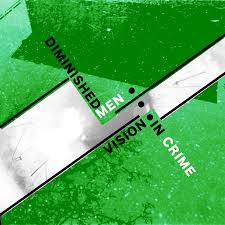Music journalists often find themselves looking around for silver nuggets (in song lyrics, press releases or a stray, indulgent melody) that, while retaining the core vision of the artist, require literary embellishment, so that the ideas embedded within them convince the hesitant public to invest their time in the record. But what if an artist becomes acutely aware that building environments is akin to dominating their art form and begins to resist exterior embellishments? What if the artist actually builds these environments and invites us to inhabit them?
Formed in 2005 by guitarist Steve Schmitt and drummer Dave Abramson, Diminished Men are no strangers to the underground music scene of the Pacific Northwest. (Abramson, especially, can claim to have done time with Master Musicians of Bukkake, Secret Chiefs 3 and Six Organs Of Admittance.) Vision In Crime is the group’s third record for Alan Bishop’s Abduction Records, but their seventh overall, if you count the numerous cassette and CD releases they put out on Bowels Of Lunacy. Joined, this time round, on Bass VI by multi-instrumentalist Simon Henneman, Vision In Crime sees the Seattle trio distil their trademark affinities for the stage and screen into a fully fledged sonic narrative, itself divorced from a concrete visual body.
Much like Philip K. Dick’s Man In The High Castle, Vision In Crime leaks from the present-familiar into the present of a parallel alien world. In this world, it is never daylight and the smog rises thick and fast from exposed ventilation shafts in the street. So far so noir, but there is more to this record than clichéd evocations of downtown dirt and fedora hats. With the introductory whining frequencies of ‘Chamber’, Diminished Men set the tone for a tense, inter-war milieu. With this relatively brief, opening statement, the group throws a loose thread in the listener’s direction. If followed carefully, this thread will unravel, revealing images, sounds and situations hidden behind the surface-fabric of the music.
The aforementioned track alludes to the claustrophobic architecture of a fallout shelter, while the deceitfully laidback ‘Kudzu Mine’ primes one for a prolonged stay in a dark and damp cavern, before casting off the veil of its sealed interior and throwing us into hot pursuit of the Other. Or is it us who are being pursued? Schmitt’s ascending/descending surf rock leitmotif sketches out a blurred portrait of a shadowy protagonist, whose fractured character reappears on other tracks and serves as a vessel for our own vague projections. Saxophonists Skerik (Critters Buggin, Wayne Horvitz) and Neil Welch (Bad Luck, King Tears Bat Trip) guest on several tracks throughout the album, including ‘Kudzu Mine’, and their interjections help to tilt the music further off balance.
At times, the combination of Gamelan instrumentation and early-1960s Stratocaster melodies steers the album into the direction of a David Lynch soundtrack. Although, stylistically, comparisons to Joe Meek or Ennio Morricone would be more precise, there is definitely a sense of an earnestly pervading overbearing strangeness on the album’s more haunting passages. Evidence of relief from the tension, feigned though it is, does become apparent with moments of funk (‘The Eye That Never Sleeps’), upbeat, filtered drums (‘Shadow Petram’) and the lazy, hauntological pirouettes on the closing title track.
One could be forgiven for describing Vision In Crime as cinematic. Not only does the title suggest that the album’s contents are the result of prophetic, oracular musings, à la Minority Report, but there are obvious allusions to film noir soundtracks throughout. The band makes no secret of their appreciation of provocative imagery by the likes of Jean-Pierre Melville or Wim Wenders. Splitting the record in two, the brief skit, ‘Preparedness Actions’, reiterates this point by providing us with chopped up segments from the infamous 1951 public information film, Duck And Cover. Our negligence, we are told, could endanger the lives of our friends and neighbours. Divorcing the speech from its original context, the band sidesteps admission of what the cause of this negligence could be. Not listening to album in its entirety, perhaps? Division In Crime is a worthwhile record. It presents the listener with a predetermined narrative, which, on the surface looks lacking in detail. It then proceeds to drop intermittent hints like a trail of sweets, inviting one to pick out certain details that guide one towards a bigger picture. Schmitt’s repetitive phrases, when pitted against Henneman’s trotting bass, embed themselves in one’s consciousness, occasionally serving as a sonic bed for one’s ruminating detective work.
There is some critique to be made, however, which takes me back to my introductory paragraph. Diminished Men do build environments which are vast and exciting, but the palette they chose to colour them with is a monochromatic one. There could be more variety in terms of melodic meanderings or even spatial awareness. Furthermore, Division In Crime is very much reliant on illustrating suggestive imagery, and it would be interesting to see if Diminished Men could take their textural template further into sonic abstraction.


